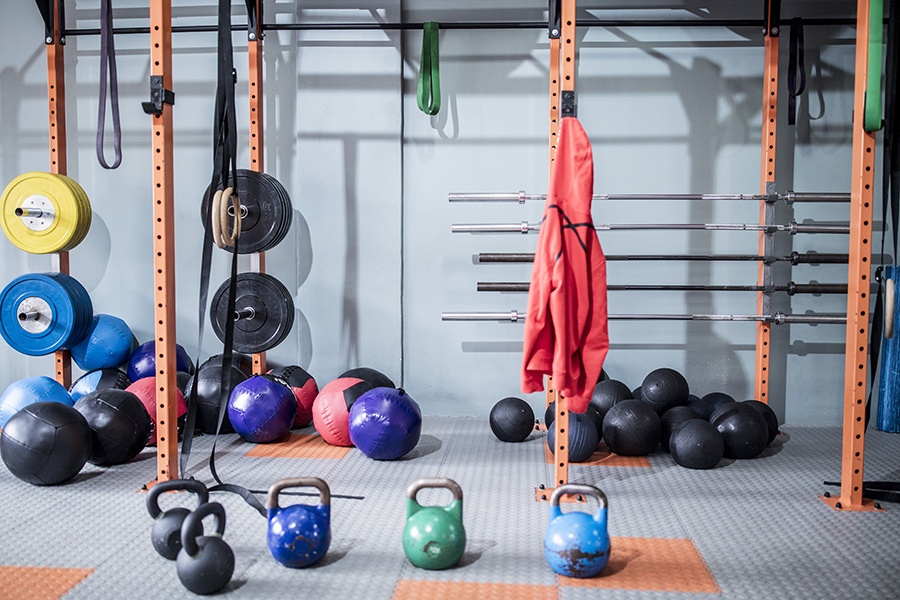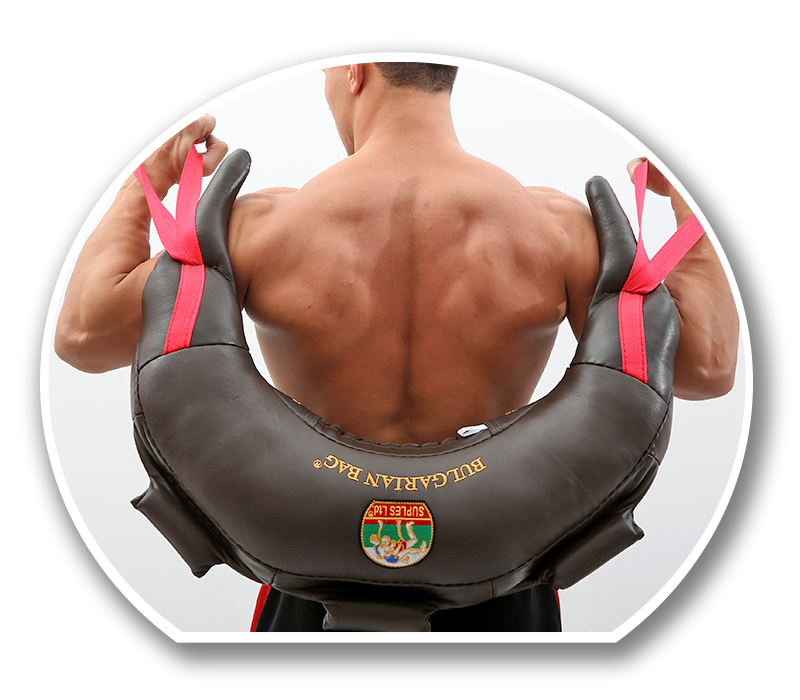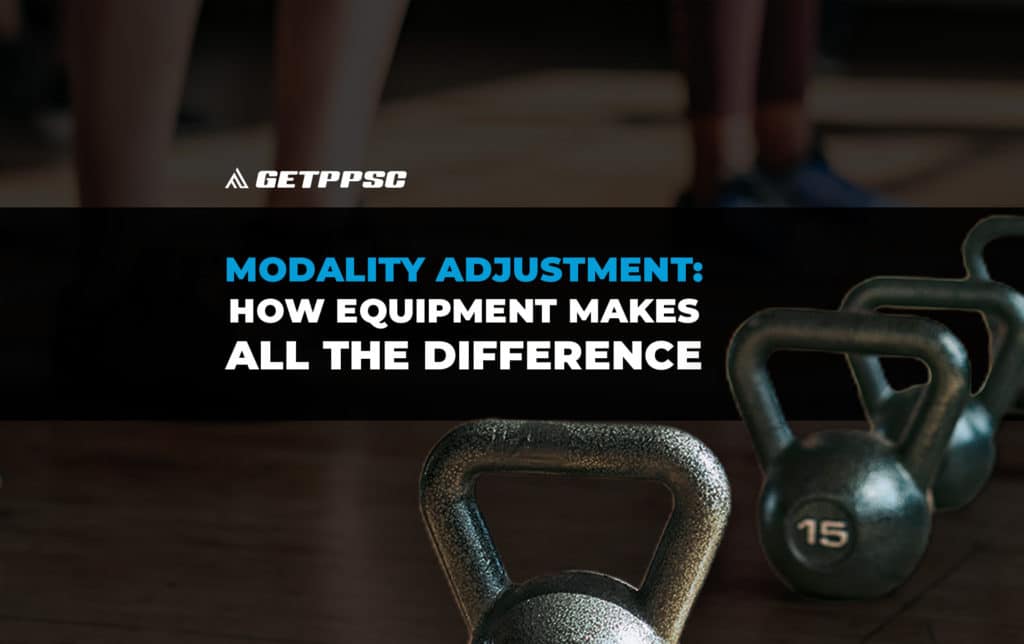We all love machines, dumbbells & barbells to train effectively and get strong. But there are LOTS of other types of equipment to choose too!
John has already talked a lot about bands and chains so let’s look at some of the other tools. The goal of this article is to describe the differences so you can decide what to include and what to leave out.
At the end of the day, smart programming requires that you progress and vary the foundational movements – you don’t have to go crazy and try to incorporate every single tool all at once (or ever.)
WHY TO INCORPORATE DIFFERENT MODALITIES

I attended a certification with a Chinese weightlifting specialist and one of the concepts he shared really stood out to me. “The best lifters are the ones who can stand the monotony of training the same lifts over and over, for years and year.”
I pretty instantly knew I was NOT one of those people. After 20+ years in the gym, I have a hard time doing 3 sets of an exercise the exact same way each time. My solution has been to join a sport, group or hire a trainer (since I am actually quite good at following instructions) or to pick workout styles that incorporate a lot of variety.
Especially since hanging up my gloves as a pro athlete, the overall goal of achieving performance & longevity can certainly be accomplished with more variety.
But, to be honest, I always carried a bit of shame that I couldn’t just “buckle down” until I learned about movement styles.
Traditional – individuals who prefer “known” exercises. Typically, more sagittal and often machine-based or using dumbbells, barbells and cables.
Progressive – individuals who prefer to move freely and play. Workouts are multiplanar and use many modalities including bodyweight, loaded movement and suspension.
Hybrid – in my experience, some people think they are traditional but it’s because they don’t know anything else. Since I’m such a fan of progressive training I can’t help but introduce it to my clients and some of them end up loving it, while still enjoying the traditional staples.
So, while many clients hire a trainer to:
• Achieve body recomposition
• Learn how to workout
• Get help with posture and/or pain
we ALSO want to help them create a sustainable, life-long commitment to health & fitness. Some folks love traditional training and, once they have created a habit and are pain-free, they can train successfully in that style long-term.
But many more people seem to use their goals as motivation to show up for a while and then they fade away. I’ve found that incorporating new skills, introducing new modalities and keeping training fresh is one of the things that has yielded retention, referrals and more enjoyment for my clients AND myself!
CLOSED-CHAIN vs OPEN-CHAIN

There are two kinds of kinetic chain exercises: open and closed.
Closed – the segment furthest away from the body (usually the hand or foot) is fixed. Ex. Hands on the bar in a chin up or feet on the ground in a squat.
Open – the segment furthest away from the body is free and not fixed to an object. Ex. hands on the suspension trainer handles in a standing chest press or feet on a glider disc for a 3D Lunge. (What’s cool about these examples is that a push-up and a split squat would both be closed chain but the introduction of a modality “opens the chain”)
SUSPENSION TRAINING

A single anchor point changes the center of gravity of the system (the straps plus the body.) A suspension trainer is a “highly portable performance training tool that leverages gravity and the user’s bodyweight to complete 100s of exercises.”
Imagine if you were hanging from a pullup bar with both hands. Your center of gravity is directly below your feet. But if you let go with one hand, you’d swing to the side. Your center of gravity is still below the anchor point but your body will now be at an angle, the feet off to one side and a bunch of muscle will have reflexively activated against this change!
This is one of the reasons suspension training is touted as “all core, all the time.” And it’s a great tool once clients have a baseline amount of body control. *If they are too weak, it can be unsafe to use suspension training.
Suspension can make an exercise EASIER by unloading bodyweight ex. TRX Squat – the client can “hold up” some of their bodyweight by pulling on the straps.
TRX SQUAT
Suspension can make an exercise VARIABLE using the vector and pendulum principles.
Vector – the angle chosen can increase or decrease the amount of load. Ex. TRX Rows – if you move your feet back (further from the anchor point) the exercise gets easier. If you move your feet forward (towards the anchor point) the exercise gets harder.
TRX ROW
Pendulum – gravity can either assist or resist the movement. Ex. TRX Hamstring Curl – if you start with your feet on the other side of the anchor point (compared to your body position) then gravity assists the movement because your feet move “downhill” as you initiate the movement.
If you start with your feet pulled back behind the anchor point (your whole body is now back from the anchor point) then gravity resists as you pull your feet “uphill” at the start of the movement.
TRX HAMSTRING CURL
Suspension can also make an exercise HARDER – the most obvious challenge is adding instability. While a push up has a certain challenge already, the TRX Push Up forces the client to control the position of the legs while suspended.
The floor is a closed-chain experience and while the hands are still grounded, the feet in the cradles are now “opened” to any movement created by a lack of stability and control! Add to that the challenge of a combination movement like the TRX Atomic Push Up and now we’re really talking.
TRX ATOMIC PUSH-UP
RIP TRAINER

The RIP Trainer is another tool adopted by the TRX family – it’s essentially a metal bar with an elastic attached to one end that “employs a resistance cord system to create a variable, unbalanced load that enables you to develop core strength, explosive rotational power, flexibility and endurance.”
Its most obvious uses are, therefore, anti-rotation and rotation (the transverse plane being a HUGELY UNDER-TRAINED OPPORTUNITY!)
RIP TRAINER COMPILATION
(OK, don’t judge me too harshly. The video was filmed when I was much younger, video editing was still new and cheesy, I had an eyebrow piercing and I matched my shoes to my training tools. I don’t want to hear ANY comments about the ending. I am willing to accept digs about the fact that I still wear outfit-matching shoes.)
KETTLEBELLS

While there are many exercises where the difference doesn’t make much difference, a kettlebell is a weighted sphere with a handle on top whereas when you hold a DB, the mass is on either side of your hand.
With a KB, there’s distance between your hand and the weight of the bell so this can act as additional lever length. The KB can either feel heavier or lighter depending on its position in space.
In a simple way, the added benefit of the KB is that there’s more stimulus for the body to adapt to so you’ll need more stability, coordination and some additional skills.
Consider a few exercise comparisons:
DB Press vs KB Press (Traditional) vs KB Bottom’s Up Press
In the traditional KB Press, the position of the KB (resting on the back of the wrist/top of the forearm) moves the load to a more posterior position and, in general, wherever the load goes, you get increased activation. Since most people need more posterior shoulder activation this can be a great option for beginners.
Now in the Bottom’s Up Press there’s a huge balance challenge going on. The weight of the bell sits up above the grip on the handle forcing you to work to stabilize that weight from toppling over.
PRO TIP: A great cue is to grip the handle tighter, increasing irradiation through the forearm, biceps and triceps and into the shoulder.
So both options increase activation of stabilizers in the shoulder but the experience of each movement is very different. Just progressing from the traditional to the bottom’s up press can feel like a huge accomplishment, even if the load stays the same!
SANDBAGS

Unlike even the unconventional tools we’ve covered so far, the sandbag is unique in that its weight shifts and moves when you do. This creates a much more dynamic and challenging workout because you use a variety of stabilization muscles that don’t typically get used, especially for higher repetitions.
One of my favourite ways to use a sandbag is for combination exercises that hit multiple (if not every) area of the body at once. You want to maximize your training time or dial up the metabolic conditioning of your workout?
Grab a sandbag.
ONNIT SANDBAG WORKOUT
BULGARIAN BAG

Do you know the origin story of the Bulgarian Bag? Towns in Bulgaria would host wrestling matches and the winner would get a sheep.
To get their prize home, the winner would grab the front legs in one hand and the back legs in the other, swing the sheep over their shoulders and carry it.
Ivan Ivanov, the bag’s creator, was invited to the US as a wrestling coach and when he arrived, the traditional gym equipment didn’t train his athletes for the rigors of the mat.
Unlike a sandbag which is designed to be loosely packed, the Bulgarian Bag is tightly packed so it simulates the solidity of throwing an active and competitive human body to the mat.
While it can be used to build strength, its main purpose was for conditioning. Like the momentum-based KB movements (swing, clean, snatch, etc.) the true spins, throws and flows that the Bag is known for must be performed with speed and momentum. You can break the movements down to a certain extent, but it either “swings” or it acts as static load.
I’m sure we’ve all seen people do walking lunges or use the stair mill with a bag and that’s fine. But the lateral and transverse movements are where the Bag provides a unique challenge. The Suples Spin is considered the signature move.
VIPR

Vitality – Performance – Reconditioning
“ViPR bridges the gap between movement and strength training. It combines full-body movement with load enhancing the goals of clients and athletes. It introduced a new concept in fitness and sports conditioning: loaded movement. [It] combines task-oriented movement patterning with resistance training. Agility and strength come form moving the body in a multitude of purposeful tasks with load.”
CREATOR MICHOL DALCOURT – T-SPINE MOBILITY
MICHOL DALCOURT – SHOVEL
STEEL MACE
:max_bytes(150000):strip_icc()/Steelmace-5a1e0343ec2f640037c71448.jpg)
Unlike the RIP trainer, the Mace is loaded with a weighted ball at the end of the stick. Beginning in the 13th century, elite warriors would train with clubs and maces to condition their bodies for battle.
The first mace was nothing more than a stone attached to a bamboo staff but, when made for battle, they were often iron or bronze.
Using the mace improves grip strength, promotes strong and healthy shoulders, delivers total body strength and conditioning and demands rotational core strength. The tool lends itself well to total body conditioning and movement flow workouts.
This is my opinion here, but steel mace is pretty much the most badass and enviable training tool out there – it’s my current struggle and fitness obsession!
ONNIT MACE WORKOUT WITH PPSC COACH JUAN LEIJA
CRAZY MACE FLOW GOALS WITH LEO SAVAGE of SteelMaceFlow
WHEN TO INCORPORATE DIFFERENT MODALITIES
At the PPSC we talk about the 3 S’s of corrective exercise: stability, sequencing and smoothness. Arguably, these 3 concepts also help us rule IN or OUT modalities. Before I show my client a TRX Chest Press I want to ensure they have a certain amount of core & shoulder stability and a pain-free pull.
I want them to be able to perform an elevated push up or a set on the chest press machine with movement quality and control. Shoot, I want them to be able to handle basic “exhale to exert” breathing because as things get more complicated, we watch that be the first thing that disappears right?!
TRX CHEST PRESS
(Sure, you can have them stand more upright but at a certain point that loses any benefit now gravity is putting their body weight directly over their feet.)
For new, intimidated, older or painful clients it can be kinder (and meet their expectations of what the workout will feel like) to get them moving in more closed-chain and traditional ways first. But as they gain competency and confidence, as they demonstrate the 3 S’s – challenge them appropriately and keep things interesting by “opening the chain” and teaching them new tools and skills!
HOW TO INCORPORATE DIFFERENT MODALITIES
PHASE CHANGES
For a more traditional client, moving them from the Chest Press Machine to a Standing Cable Chest Press is already a change – from a closed-chain exercise to an open-chain exercise.
But if they enjoy the challenge of controlling the user-directed path of motion using the cables, they may enjoy the additional core challenge of the TRX Chest Press.
So, one method of introducing different modalities is simply to replace one or two exercises in the pre-existing workout with something more unconventional.
INTRA-WORKOUT CHANGES
Another way to introduce change is to offer a more traditional exercise for the 1st set and then apply an unconventional change for the next set.
This is a great choice for progressive clients (or if you’re trying to learn about a client’s preferred movement style.)
Ex. Set 1 – DB Reverse Lunge ???? Set 2 – TRX (Suspended) Lunge
This is a great way to show clients the difference and ask for feedback!
“Out of those 2, which one did you enjoy more?”
“Which one felt more challenging?”
“Which one got you feeling your glutes more?”
GOAL-RELATED CHANGES
Lots of clients have body recomposition changes so, as trainers, we can get stuck in a bit of a rut and almost expect that when we meet someone new, however, not everyone wants (or needs) to prioritize that AND there are lots of benefits in thinking about the activities a client will be performing OUTSIDE the gym.
I always try to encourage clients to take up a sport or hobby – something that supports their overall goals and encourages more daily movement and can be enjoyable and create more social support!
Often this is something clients will have to think about for a while, but when they tell me something new, they want to try (like paddle boarding, hiking or ballroom dancing) it can be an obvious fit to introduce some new modalities that support the requirements of that choice.
Paddle boarding ???? RIP trainer (there’s lots of different push & pull variations where the band can be used to create the resistance the water will provide.)
Hiking ???? Sandbag (dealing with constantly shifting sand is similar to hiking across uneven terrain in terms of focus, balance and readjustment.)
Ballroom Dancing ???? Bulgarian Bag (I’m NOT referencing man-handling your partner lol! I’m talking about learning to coordinate and move WITH another body mass.)
I’m going to wrap this up by sharing one last thing. A few years ago, when I got into fitness education full-time, I asked my fiancé, “From the perspective of being a member/client, what’s one thing you think trainers shoulder know?”
She answered really quickly.
“Don’t give me an exercise that you can’t do.”
She’s pretty direct ???? But, she’s also right. If you’re going to move beyond your beloved machines, barbells, cables and dumbbells for the funky forest of functional fitness tools then you’ve got to be willing to spend some/a lot of time learning, practicing, struggling, progressing, polishing and moving towards mastery.
You can certainly start to show clients the basics as you move into more challenging variations. But don’t let your enthusiasm cloud your responsibility to safely & effectively help your clients reach their goals!
One thing I have learned over more than a decade of working with unconventional training tools is that there’s a big difference between being able to DO the movement myself and having done it for so long, in so many ways and really understanding the movement so that I can TEACH a client HOW to do it. There IS NO SHORTCUT to experience.
And experience is just about priceless. Happy training!




